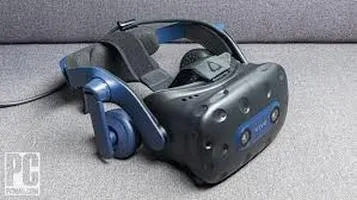A Comprehensive Review of VR Headsets: Are They Worth the Hype?
Virtual Reality (VR) headsets are cutting-edge devices designed to immerse users in a simulated environment, offering a sense of presence in a digital world. These headsets often consist of a stereoscopic display, stereo sound, and motion tracking sensors, providing an interactive experience that mimics real-life movements. By covering the user's field of vision, VR headsets create a 3D effect, enabling users to explore virtual spaces as if they were physically present. They are used in various fields, from gaming and entertainment to education and professional training, allowing for realistic simulations and experiential learning. As technology advances, VR headsets continue to evolve, becoming more lightweight, affordable, and user-friendly, thereby enhancing the accessibility and appeal of virtual reality experiences.

Virtual Reality (VR) headsets have rapidly evolved from a niche gadget for tech enthusiasts to a mainstream gaming and entertainment device. With several brands and models flooding the market, it’s crucial to understand whether these devices live up to the hype. This review delves into the various aspects of VR headsets, exploring their design, functionality, content availability, and overall user experience.
Design and Comfort
One of the first things you notice about VR headsets is their design. Modern VR headsets like the Oculus Quest 2, PlayStation VR, and HTC Vive Pro have made significant strides in balancing aesthetics with ergonomics. The Oculus Quest 2, for example, boasts a sleek, minimalist design that appeals to a broad audience. Its light weight and adjustable head straps make it comfortable to wear for extended periods.
However, not all headsets get it right. Some models, particularly earlier iterations, can be bulky and cumbersome. Comfort is a critical factor because even slight discomfort can detract from the immersive experience that VR aims to provide. Newer models are incorporating softer padding, better weight distribution, and customizable fittings to tackle this issue.
Display and Audio Quality
The display quality of VR headsets has seen remarkable improvements. The Oculus Quest 2 features a high-resolution display with 1832 x 1920 pixels per eye, offering crisp and clear visuals. Similarly, the Valve Index boasts an impressive 1440 x 1600 resolution per eye, with a refresh rate of up to 144Hz, making the experience incredibly smooth and lifelike.
Audio is another critical component of VR immersion. Many high-end VR headsets now come equipped with built-in spatial audio, adding another layer of realism. The HTC Vive Pro, for example, includes integrated headphones that offer 3D spatial sound, enhancing the sense of being in a different world.
Controllers and Tracking
Controllers and tracking systems are pivotal to the VR experience. The Oculus Quest 2 uses intuitive Touch Controllers that allow for natural hand movements, making interactions in the virtual world feel more lifelike. The PlayStation VR uses PlayStation Move controllers, which, while not as advanced, still offer a decent level of interaction.
Tracking technology varies between headsets. The Oculus Quest 2 and the HTC Vive Pro use inside-out tracking, meaning the cameras and sensors are built into the headset itself. This setup is convenient as it eliminates the need for external sensors. On the other hand, systems like the Valve Index use external base stations for tracking, which can offer more precise tracking but require additional setup.
Content and Compatibility
Content is where VR headsets truly differentiate themselves. Oculus, now owned by Facebook, has a robust library of games and applications available through the Oculus Store. Titles like "Beat Saber," "Superhot VR," and "Half-Life: Alyx" have set high standards for what VR gaming can achieve.
PlayStation VR leverages the extensive library of PlayStation games, offering exclusive titles like "Astro Bot Rescue Mission" and "Blood & Truth." However, it’s worth noting that PlayStation VR is tied to the PlayStation console, limiting its use compared to standalone systems like the Oculus Quest 2.
The SteamVR platform, compatible with headsets like the Valve Index and HTC Vive, offers a diverse range of VR experiences, from high-octane games to educational applications. The open nature of the platform also means that users can access a broader array of indie titles and experimental content.
Price and Value
Price is often a significant consideration for consumers. The Oculus Quest 2 is arguably the best value for money, starting at $299. Its all-in-one nature means you don’t need a high-end PC or gaming console to enjoy VR. PlayStation VR is also relatively affordable, but it requires a PlayStation console, adding to the overall cost.
High-end systems like the Valve Index and HTC Vive Pro come with a heftier price tag, often exceeding $1,000 when you factor in the necessary accessories and a capable PC. These systems are geared towards enthusiasts who seek the highest quality experience and are willing to invest accordingly.
The Future of VR
The future of VR looks promising, with advancements in technology continually pushing the boundaries of what’s possible. Companies are exploring haptic feedback, eye-tracking, and even full-body tracking to enhance immersion. The integration of 5G technology could also revolutionize VR by reducing latency and enabling more complex multiplayer experiences.
Conclusion
VR headsets have come a long way, evolving from clunky, experimental devices to polished, sophisticated gadgets that offer a truly immersive experience. Whether you're a gamer, a movie buff, or someone interested in virtual tourism or education, there's likely a VR headset that suits your needs.
While high-end models offer unparalleled quality, budget-friendly options like the Oculus Quest 2 provide excellent value and accessibility. As technology continues to advance and more content becomes available, the case for integrating a VR headset into your entertainment arsenal becomes increasingly compelling. If you haven't yet taken the plunge into virtual reality, now might be the perfect time to explore this exciting frontier.






